What Is the Meaning of Falling in Reverse’s Symbol?
The symbols associated with Falling in Reverse profoundly encapsulate themes of transformation, resilience, and existential struggles. The Phoenix represents rebirth, highlighting the band's journey through adversities.
The Broken Heart symbolizes emotional turmoil and personal hardships. Skulls and hourglasses signify mortality and the relentless passage of time, while the Ouroboros reflects the cyclical nature of life and rebirth.
Chains and keys denote internal constraints and the quest for liberation through self-discovery. Roses and crows add layers of beauty, mystery, and intelligence, underscoring the band's edge and artistic depth.
Explore further to uncover more intricate meanings behind these evocative symbols.
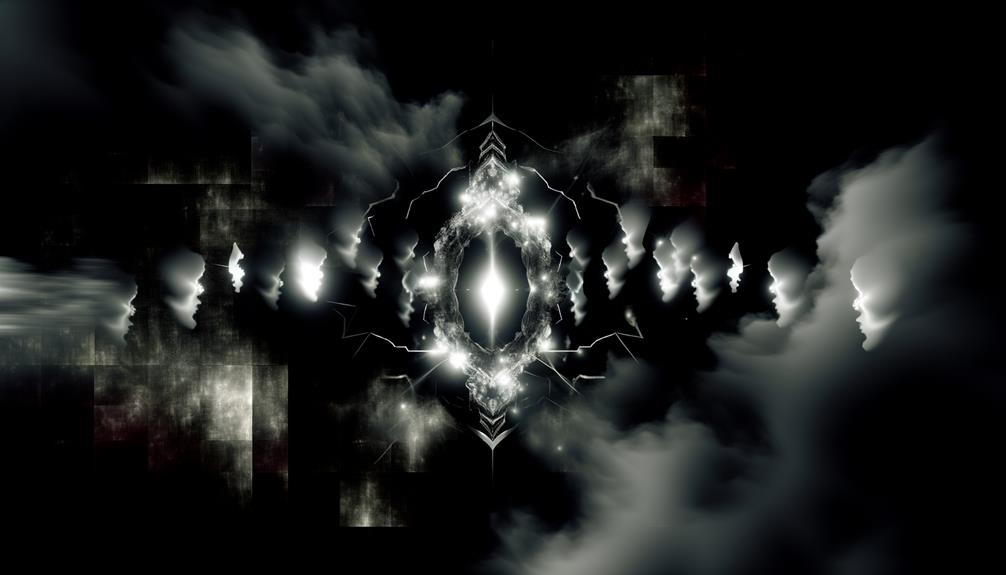
Key Takeaways
- The Phoenix symbolizes rebirth, resilience, and personal transformation.
- The Broken Heart represents emotional turmoil and symbolic heartbreak.
- The Skull signifies mortality, rebellion, and countercultural movements.
- The Chains depict internal and external constraints, while the Key symbolizes liberation and inner strength.
- The Mask represents identity, deception, and the journey of self-discovery.
The Phoenix
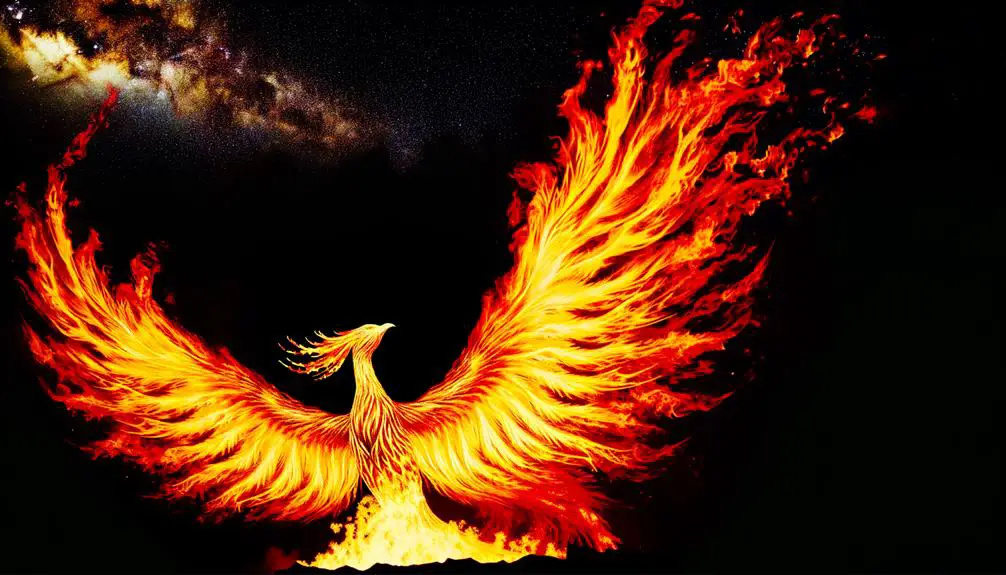
In the context of 'Falling in Reverse,' the symbol of the Phoenix epitomizes themes of rebirth, resilience, and transformation. As the mythical bird rises anew from its ashes, it mirrors the band's narrative of overcoming adversity and evolving through challenges.
Lead vocalist Ronnie Radke often embodies this symbolism, reflecting his personal journey of redemption and growth after past tribulations. This motif resonates deeply within the rock genre, where stories of overcoming hardship and reinventing oneself are prevalent.
The Phoenix not only underscores the band's thematic focus but also serves as a powerful metaphor for its artistic evolution, inspiring listeners to embrace their own potential for renewal and strength in the face of life's inevitable trials.
The Broken Heart
The broken heart serves as a powerful motif in Falling in Reverse's oeuvre, encapsulating themes of emotional turmoil and symbolic heartbreak. This imagery not only resonates with listeners on a personal level but also reflects the band's identity, often grappling with raw vulnerability and resilience.
Emotional Turmoil Depiction
As an emblem of emotional turmoil, the broken heart in Falling in Reverse's symbolism poignantly encapsulates the pain and disarray accompanying profound personal loss. This imagery evokes visceral emotions, reflecting the chaotic aftermath of severed relationships and shattered dreams.
The band's lyrical content often explores themes of betrayal, regret, and inner conflict, painting a vivid picture of a fractured psyche. The broken heart serves as a powerful metaphor, resonating with listeners who have experienced similar anguish.
Symbolic Heartbreak Representation
Depicted as a shattered emblem of despair, the broken heart in Falling in Reverse's visual and lyrical artistry profoundly illustrates the intricacies of symbolic heartbreak. This motif transcends mere aesthetic, embodying a visceral portrayal of emotional fragmentation.
Through jagged visuals and poignant lyrics, the band captures the raw, unfiltered core of pain and loss. The broken heart serves as a universal symbol, resonating deeply with listeners who have faced similar emotional turmoil.
It also amplifies the band's thematic exploration of vulnerability and resilience, revealing the delicate balance between destruction and healing. Essentially, the broken heart becomes a powerful narrative device, encapsulating both personal and collective experiences of love's inevitable tragedies.
Band Identity Reflection
Symbolizing the band's raw emotional core, the shattered heart motif in Falling in Reverse's work poignantly reflects their identity through themes of vulnerability and resilience.
This symbol is not merely a symbol of sorrow but a tribute to the band's journey through personal turmoil and artistic evolution.
Frontman Ronnie Radke's lyrics often explore the complexities of human emotion, juxtaposing despair with an unwavering spirit.
The shattered heart becomes a storytelling device, illustrating the band's struggles and triumphs in the turbulent landscape of the music industry.
The Skull
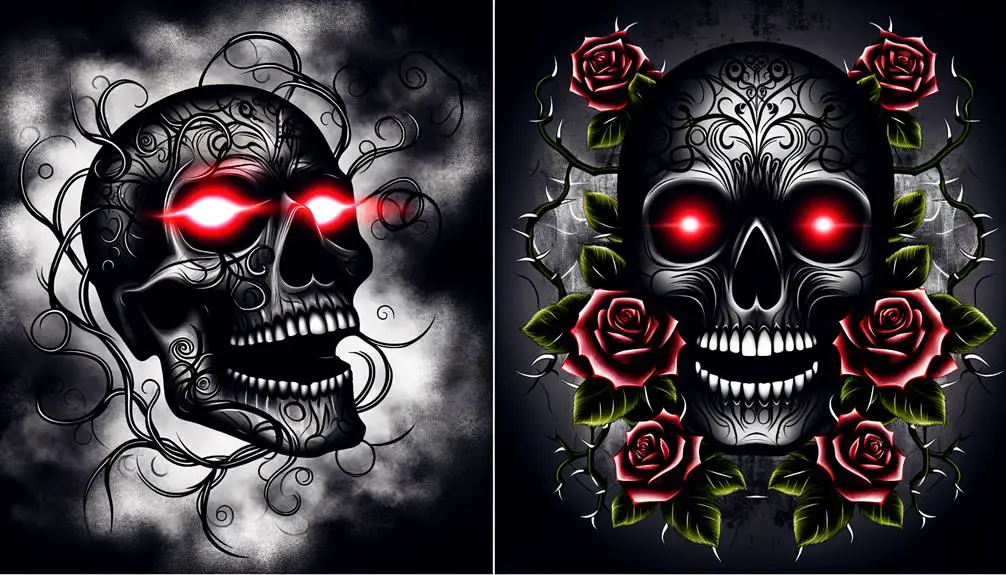
The skull, as a potent symbol, carries a multifaceted significance that transcends mere macabre imagery. Historically, it has represented mortality and the ephemeral nature of life, while culturally, it has been appropriated to signify rebellion and countercultural movements.
This duality makes the skull a compelling emblem in the context of Falling in Reverse, reflecting themes of existential contemplation and societal defiance.
Symbolic Representation
In many cultural and artistic contexts, the skull serves as a powerful symbol of mortality and the existential realities that underlie human experience.
In modern symbolism, especially within the field of music and visual art, the skull can convey multiple layers of meaning:
- Memento Mori: Reminding individuals of the inevitability of death, urging them to lead meaningful lives.
- Rebellion: Often employed in rock and alternative genres, the skull signifies defiance against societal norms and conventions.
- Metamorphosis: Representing change and the cyclical nature of life, the skull underscores the shift from one state of being to another.
Understanding these symbolic representations allows for a deeper appreciation of their use in various media, enriching the audience's interpretative experience.
Historical Significance
Tracing its roots back to ancient civilizations, the skull has long been imbued with profound historical significance, often serving as a potent emblem in rituals, art, and mythology. In ancient Mexico, skulls were integral to the Day of the Dead celebrations, symbolizing the cyclical nature of life and death. Similarly, in medieval Europe, the skull and crossbones were used to denote death and ward off grave robbers. The following table highlights key periods and their associations with skull imagery:
| Era | Region | Symbolic Use |
|---|---|---|
| Ancient Mexico | Mesoamerica | Day of the Dead, honoring ancestors |
| Medieval Europe | Europe | Skull and crossbones, warning of mortality |
| Victorian Era | Britain | Memento mori, contemplation of mortality |
This historical context underscores the skull's enduring resonance across cultures.
Cultural Impact
Skull imagery saturates modern culture, resonating through fashion, music, and art as a symbol of rebellion, mortality, and identity. This pervasive symbol has transcended its macabre origins to become a multifaceted icon.
In the domain of cultural impact, skulls signify more than just death; they embody a countercultural ethos that challenges societal norms and embraces individuality. Key areas where skull symbolism thrives include:
- Fashion: Skulls are ubiquitous in streetwear, luxury brands, and accessories, symbolizing edginess and nonconformity.
- Music: Particularly in rock and metal genres, skulls adorn album covers, merchandise, and stage designs, signifying defiance and raw emotion.
- Art: Contemporary artists use skulls to explore themes of life, death, and the human condition, often provoking thought and introspection.
Understanding these aspects provides insight into the skull's enduring cultural relevance.
The Hourglass
An hourglass, often depicted in the band's symbolism, represents the relentless passage of time and the inevitable march toward one's destiny.
In Falling in Reverse's visual and lyrical motifs, the hourglass encapsulates themes of urgency and the transient nature of human existence.
This iconography serves to remind listeners of life's fleeting moments, urging them to seize opportunities and confront their own temporality.
The grains of sand slipping through the hourglass can be seen as a metaphor for choices made and paths taken, highlighting the consequences that shape one's journey.
The Ouroboros

Falling in Reverse's frequent use of the Ouroboros, a serpent eating its own tail, powerfully symbolizes the cyclical nature of life, death, and rebirth, reflecting themes of renewal and perpetual transformation in their artistry. This ancient emblem resonates with the band's exploration of existential motifs, bridging the gap between destruction and creation.
The Ouroboros in their work can be dissected into three critical components:
- Eternal Recurrence: Signifying that every end heralds a new beginning.
- Self-Reflection: Highlighting the necessity of introspection for personal growth.
- Transformation: Emphasizing the constant metamorphosis inherent in human experience.
Such symbolism not only deepens the narrative layers within their music but also invites listeners to contemplate the profound cycles governing their own lives.
The Crow
The enigmatic presence of the crow in Falling in Reverse's iconography serves as a potent symbol of mystery, intelligence, and transformation, mirroring the band's exploration of life's darker and more introspective themes.
Crows, often associated with death and the unknown, resonate deeply within the band's lyrical content and visual storytelling. Their intelligence and adaptability reflect the band's musical evolution and resilience in the face of personal and artistic challenges.
Additionally, the crow's role as a harbinger of change underscores themes of rebirth and redemption that permeate the band's work. By employing the crow, Falling in Reverse invokes a multifaceted symbol that enriches their narrative, inviting listeners to explore deeper into the complexities of human experience.
The Mask
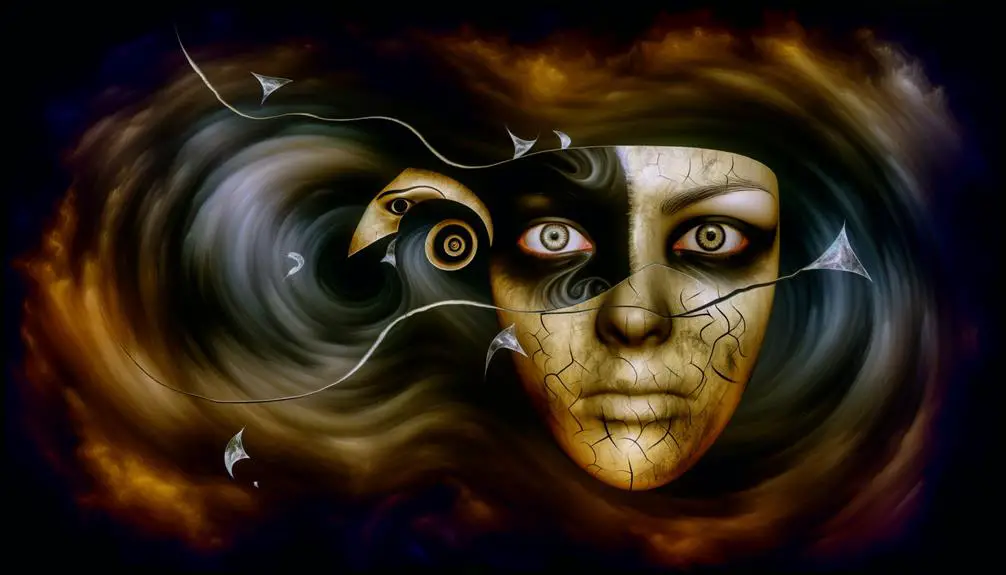
In the intricate tapestry of Falling in Reverse's visual and lyrical motifs, the mask emerges as a powerful symbol of identity, deception, and self-discovery. The mask serves as a metaphorical device, encapsulating the complexities of human nature and the struggle between one's true self and societal expectations.
Through its use, the band explores deeply into themes that resonate with their audience, such as:
- Identity Crisis: The mask represents the conflict between authentic self and the facade worn for acceptance.
- Deception: It highlights the duplicity in relationships and the masks people wear to conceal their true intentions.
- Self-Discovery: The removal of the mask signifies a journey towards understanding and embracing one's true identity.
This multifaceted symbol enriches the narrative complexity of their work.
The Key
Accessing the thematic depth of Falling in Reverse's work, the key symbolizes the gateway to understanding, freedom, and transformation within their narrative universe. It serves as an emblem of revealing hidden truths and escaping confines, both literal and metaphorical.
This potent symbol frequently appears in their lyrics and visuals, guiding the audience through layers of personal and existential exploration. The key's representation often intertwines with themes of self-discovery and redemption, suggesting that liberation and clarity are attainable through inner strength and resilience.
The Chains
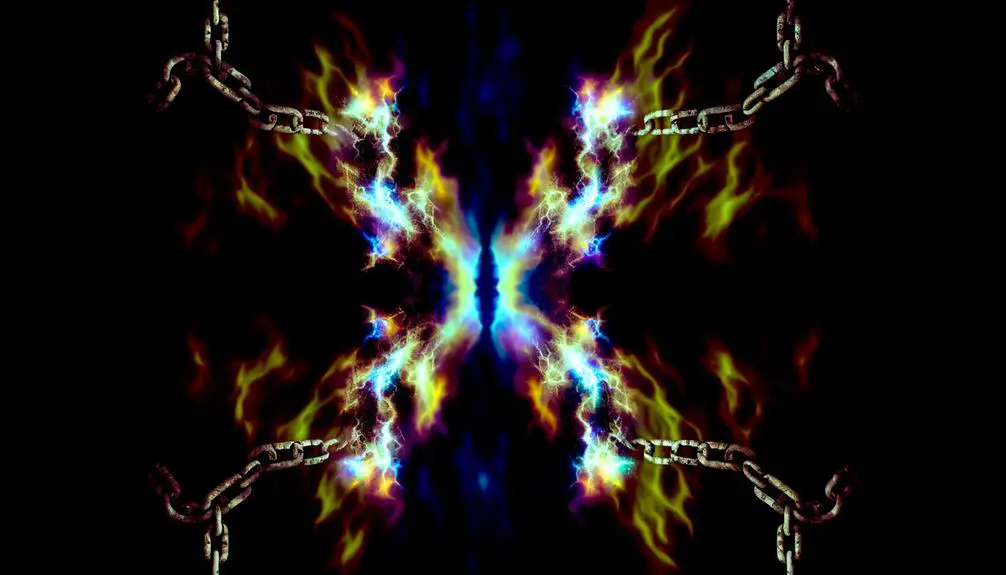
Chains within Falling in Reverse's oeuvre symbolize the shackles of internal and external constraints that characters must confront and overcome. These constraints manifest in various forms throughout their music, representing the struggles and conflicts faced by individuals.
The chains serve as metaphors for:
- Personal struggles: Internal battles with addiction, mental health, and self-doubt.
- Societal pressures: External expectations and judgments that stifle individuality and freedom.
- Emotional entanglements: Relationships and past experiences that anchor characters to pain and regret.
Through their evocative lyrics and powerful imagery, Falling in Reverse crafts narratives that resonate deeply with listeners, highlighting the universal human desire to break free from life's pervasive chains. This recurring motif underscores the band's commitment to exploring themes of liberation and self-discovery.
The Rose
While chains represent the oppressive constraints within Falling in Reverse's music, the rose emerges as a nuanced symbol of beauty amidst adversity and the potential for redemption. This floral emblem often juxtaposes the harsh realities depicted in the band's lyrics, symbolizing resilience and hope.
The rose, with its delicate petals and thorny stems, encapsulates the dual nature of life—the coexistence of pain and beauty. By integrating this symbol, the band crafts a narrative where suffering is met with the possibility of growth and renewal.
The rose serves not merely as an aesthetic choice but as a profound metaphor for overcoming tribulations and finding grace within turmoil, resonating deeply with their audience's quest for meaning and solace.
The Eye
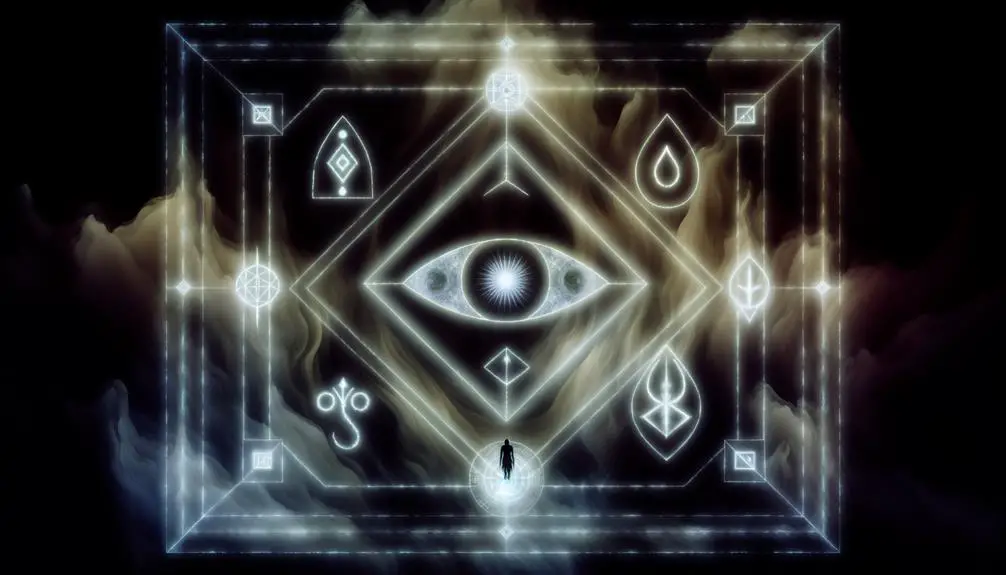
Central to the iconography of Falling in Reverse, the eye symbolizes perception, awareness, and the search for deeper truths within the chaos of existence. This emblematic image captures the essence of introspection and vigilance, resonating deeply with fans who seek meaning beyond the surface.
In their music and visuals, the eye serves as a powerful motif that underscores the band's exploration of inner turmoil and enlightenment.
Key representations of the eye in Falling in Reverse's work include:
- Album Art: The eye often appears prominently in their album covers, suggesting a gateway to understanding the band's message.
- Music Videos: Visuals featuring the eye accentuate themes of revelation and insight.
- Lyrics: References to seeing and vision emphasize the quest for clarity amidst confusion.
This symbol intricately weaves the band's narrative, inviting audiences to look beyond the obvious.
Conclusion
In summation, the symbols associated with Falling in Reverse—ranging from the Phoenix to the Eye—serve as a veritable time machine, transporting audiences through a labyrinth of existential themes.
Each emblem, whether it be the cyclical Ouroboros or the fragile Hourglass, encapsulates a facet of human experience.
These symbols are not mere adornments but are integral to understanding the band's narrative, offering a rich tapestry of meaning that resonates on both personal and collective levels.






